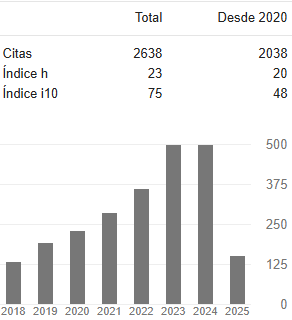Vitamina C y color superficial en tomate y pimentón verde: efecto de los tratamientos térmicos
DOI:
https://doi.org/10.31908/19098367.313Palabras clave:
CIEL*a*b*, cocción, pH, solidos solubles, tonoResumen
El objetivo de esta investigación fue determinar el efecto de los tratamientos térmicos en la concentración de ácido ascórbico y color superficial en frutos de tomate y pimentón. Muestras de 100 g se sometieron a la cocción con microondas (800 w durante 2 minutos), horno (200°C) vapor (97 °C) y agua (98 °C) durante 10 minutos, se enfriaron rápidamente a 5 °C y se procedió a determinar la concentración de ácido ascórbico, y las coordenadas colorimétricas CIEL*a*b*. El tratamiento con horno presentó estadísticamente la mayor reducción de ácido ascórbico al registrar pérdidas del 80% de este antioxidante, y en pimentón verde, el tratamiento de cocción con agua redujo en un 51,73% la concentración de este micronutriente. Por otra parte, los tratamientos térmicos no afectaron el color superficial de los frutos de tomate y pimentón.
Descargas
Referencias
JFAOSTAT (2015). http://faostat3.fao.org/download/Q/*/E. Citado el 21 de octubre de 2015
R. P. Guiné, and M. J Barroca, (2012). Effect of drying treatments on texture and color of vegetables (pumpkin and green pepper). Food and Bioproducts Processing, vol. 90, no. 1, pp. 58-63. 2012.
L. E. Ordoñez-Santos, and D. P. Ledezma-Realpe, Lycopene Concentration and Physico-Chemical Properties of Tropical Fruits. Food and Nutrition Sciences, vol. 4 no. 7, pp. 758-762. 2013.
A. H. Azizah, K. C. Wee, O. Azizah, and M. Azizah, Effect of boiling and stir frying on total phenolics, carotenoids and radical scavenging activity of pumpkin (Cucurbita moschato). International Food Research Journal, vol. 16 no. 1, pp.45-51, 2009.
R. M. Robles-Sánchez, M. A. Rojas-Graü, I., Odriozola-Serrano, G A. González-Aguilar, and O. Martín-Belloso, Effect of minimal processing on bioactive compounds and antioxidant activity of freshcut ‘Kent’mango (Mangifera indica L.). Postharvest Biology and Technology, vol. 51 no. 3, pp. 384-390, 2009.
P. Hiwilepo-van Hal, C. Bosschaart, C. van Twisk, R. Verkerk, and M. Dekker, Kinetics of thermal degradation of vitamin C in marula fruit (Sclerocarya birrea subsp. caffra) as compared to other selected tropical fruits. LWT-Food Science and Technology, vol. 49, no. 2, pp. 188-191, 2012.
I. Van Bree, J. M. Baetens, S. Samapundo, F. Devlieghere, R. Laleman, I. Vandekinderen, B. Noseda, R. Xhaferi, B. De Baets, and B De Meulenaer, Modelling the degradation kinetics of vitamin C in fruit juice in relation to the initial headspace oxygen concentration. Food Chemistry, Vol. 134, no. 1, pp.207-214, 2012.
M. Aamir, M. Ovissipour, B. Rasco, J. Tang, and S. Sablani, Seasonality of the Thermal Kinetics of Color Changes in Whole Spinach (Spinacia Oleracea) Leaves Under Pasteurization Conditions.d International Journal of Food Properties, vol.17, no. 9, pp. 2012-2024, 2014.
N. Bineesh, R. S. Singhal, and A. Pandit, A study on degradation kinetics of ascorbic acid in drumstick (Moringa olifera) leaves during cooking. Journal of the Science of Food and Agriculture, vol. 85, pp.1953-1958, 2005.
R. Blasco, M. J. Esteve, A. Frı́gola, and M. Rodrigo, Ascorbic acid degradation kinetics in mushrooms in a high-temperature short-time process controlled by a thermoresistometer. LWT-Food Science and Technology, vol. 37, no. 2, pp.171-175, 2004.
A. W. Munyaka, E. E. Makule, I. Oey, A. Van Loey, and M. Hendrickx, Thermal Stability of l Ascorbic Acid and Ascorbic Acid Oxidase in Broccoli (Brassica oleracea var. italica). Journal of food science, vol. 75, no. 4, pp, C336-C340, 2010.
A.F. Pighín, and A.L Rossi. Espinaca fresca, supercongelada y en conserva: contenido de vitamina C pre y post cocción. Revista chilena de nutrición, vol. 37, no. 2, pp. 201-207, 2010.
J. Ahmed, U. S. Shivhare, and S. Debnath, Colour degradation and rheology of green chilli puree during thermal processing. International journal of food science & technology, Vol. 37, no. 1, pp. 57-63, 2002.
J. Ahmed, U.S. Shivhare, and P. Singh, Colour kinetics and rheology of coriander leaf puree and storage characteristics of the paste. Food Chemistry, Vol. 84, no. 4, pp.605-611, 2004.
D. Dutta, A. Dutta, U. Raychaudhuri, and R. Chakraborty, Rheological characteristics and thermal degradation kinetics of beta-carotene in pumpkin puree. Journal of food engineering, Vol. 76, no. 4, pp. 538- 546, 2006.
A.K. Jaiswal, and N. Abu-Ghannam, Degradation kinetic modelling of color, texture, polyphenols and antioxidant capacity of York cabbage after microwave processing. Food Research International, Vol. 53 no. 1, 125-133, 2013.
NTC 4592. (1999). Productos de frutas y verduras. Determinación del pH. Bogotá: Instituto Colombiano de Normas Técnicas y Certificación ICONTEC.
NTC 4623. (1999). Productos de frutas y verduras. Determinación de la acidez titulable. Bogotá: Instituto Colombiano de Normas Técnicas y Certificación-ICONTEC.
NTC 4624. (1999). Jugos de Frutas y Hortalizas. Determinación del contenido de solidos solubles. Método refractómetro. Bogotá: Instituto Colombiano de Normas Técnicas y Certificación-ICONTEC.
L.E. Ordoñez-Santos, and A. Vásquez-Riascos, Effect of processing and storage time on the vitamin C and lycopene contents of néctar of pink guava (Psidium guajava L.). Archivos Latinoamericanos de Nutrición, Vol. 60, no. 3, pp. 280-284, 2010.
I. Odriozola-Serrano, R. Soliva-Fortuny, and O. Martín-Belloso, Effect of minimal processing on bioactive compounds and color attributes of fresh-cut tomatoes. LWT-Food Science and Technology, vol. 41, no. 2, pp. 217-226, 2008.
J.J. Ruiz, N. Martínez, García Martínez S, M. Serrano, M. Valero, and R. Moral, Micronutrient composition and quality characteristics of traditional tomato cultivars in southeast Spain. Communications in soil science and plant analysis, Vol. 36, no. 4-6, pp. 649-660, 2005.
V. Dewanto, X. Wu, K. K. Adom, and R.H. Liu, Thermal processing enhances the nutritional value of tomatoes by increasing total antioxidant activity. Journal of agricultural and food chemistry, Vol. 50, no. 10, pp. 3010-3014, 2002.
S. Gahler, K. Otto, and V. Böhm, Alterations of vitamin C, total phenolics, and antioxidant capacity as affected by processing tomatoes to different products. Journal of Agricultural and Food Chemistry, Vol. 51, no. 27, pp. 7962-7968, 2003.
E. Sahlin, G. P. Savage, and C. E. Lister, Investigation of the antioxidant properties of tomatoes after processing. Journal of Food Composition and Analysis, Vol. 17, no 5, pp. 635-647, 2004.
F.E. Quipo Muñoz, A.M. Ramírez Muñoz, J.A. Rojas Pérez y LE. Ordoñez Santos, Changes in Vitamin C and Color during Cooking Of Green Peppers (Capsicum Annuum L). Tecno. Lógicas., No. 31, pp. 141-150, 2013.
A. M. Chuah, Y. C. Lee, T. Yamaguchi, H. Takamura, L. J, Yin,and T. Matoba, Effect of cooking on the antioxidant properties of coloured peppers. Food Chemistry, Vol. 111 no. 1, pp. 20-28, 2008.
G. Cocetta, V. Baldassarre, A. Spinardi, and A. Ferrante, Effect of cutting on ascorbic acid oxidation and recycling in fresh-cut baby spinach (Spinacia oleracea L.) leaves. Postharvest Biology and Technology, Vol. 88, pp. 8-16, 2014.
H. M., Serra, Cafaro, T. A, Ácido ascórbico: desde la química hasta su crucial función protectiva en ojo. Acta bioquímica clínica latinoamericana, Vol 4, no. 4, pp. 525-532, 2007.
D.J. Ornelas-Paz, L. A. Cira-Chávez, A. A. Gardea-Béjar, J. C. Guevara-Arauza, D. R. Sepúlveda, J. Reyes-Hernández, and S. Ruiz Cruz, Effect of heat treatment on the content of some bioactive compounds and free radical-scavenging activity in pungent and nonpungent peppers. Food Research International, Vol. 50, no. 2, pp. 519- 525, 2013.
M. E. A, Toledo,. Ueda, Y., Imahori, Y., Ayaki, M, L-ascorbic acid metabolism in spinach (Spinacia oleracea L.) during postharvest storage in light and dark. Postharvest biology and technology, Vol. 28, no. 1, pp. 47-57, 2003.
Y. Hernández, Lobo, M. G., & González, M, Determination of vitamin C in tropical fruits: A comparative evaluation of methods. Food chemistry, Vol 96, no. 4, pp. 654-664, 2006.
Descargas
Publicado
Número
Sección
Licencia
Derechos de autor 2019 Entre Ciencia e Ingeniería

Esta obra está bajo una licencia internacional Creative Commons Atribución-NoComercial 4.0.



















